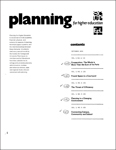- Integrated Planning
Integrated Planning
Integrated planning is a sustainable approach to planning that builds relationships, aligns the organization, and emphasizes preparedness for change.
- Topics
Topics
- Resources
Resources
Featured Formats
Popular Topics
- Events & Programs
Events & Programs
Upcoming Events
- Community
Community
The SCUP community opens a whole world of integrated planning resources, connections, and expertise.
- Integrated Planning
Integrated Planning
Integrated planning is a sustainable approach to planning that builds relationships, aligns the organization, and emphasizes preparedness for change.
- Topics
Topics
- Resources
Resources
Featured Formats
Popular Topics
- Events & Programs
Events & Programs
Upcoming Events
- Community
Community
The SCUP community opens a whole world of integrated planning resources, connections, and expertise.
We're grateful for our community and wish you a happy holiday! Please note the SCUP Office will be closed November 26-27. Planning for Higher Education Journal
Planning for Higher Education JournalConnecting Campus, Community and School
 From Volume 3 Number 5 | October 1974By Charlotte Mitau, P.R. Theibert
From Volume 3 Number 5 | October 1974By Charlotte Mitau, P.R. TheibertThe Society's West Coast Regional Long Range Planning Workshop, held January 17-19, 1974 in San Diego, was entitled, "Academic, Physical and Community Planning: Opportunities for Intergration." John Vasconcellos, California Assemblyman, chairman of the California Joint Legislative Committee on the Study of the Master Plan for Higher Education, and a participant in the workshop, stated that this title failed to convey the urgent necessit for cooperative planning between educational and community institutions. His alternative title, "The Necessity for Connectedness," met with general approval. At the workshop, Charlotte Mitau, president of the St. Pau, Minnesota Board of Education, pointed to the need for increased participation by higher education in the training of personnel and the preparation of curricula for primary and secondary education. P.R. Theibert, special assistant to the president at Hofstra University and consultant to Educational Facilities Laboratories, focused on artificial turf and membrane roofs as leading examples of the evolution of the school gymnasium into the open multi-use recreational facility. the exerpts below from the remarks of these two workshop participants illustrate the range of options available to administrators seeking to make educational resources available to the entire community.
MEMBERS ONLY
Attention Members: Log in to access this item.Not a member? Join now to access this article and all journal articles for free. - Topics
- Topics


